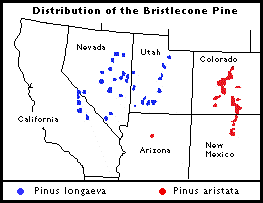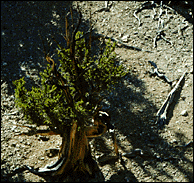
On dry windswept mountaintops of the Great Basin in the western United States grow earth's oldest living inhabitants, the bristlecones (Pinus longaeva, Pinus aristata). Many of the trees living today were seedlings when the pyramids were being constructed, mature in the time of Christ, and ancient patriarchs today. Bristlecones occur in only six western states, but of these the oldest are found at the Ancient Bristlecone Pine Forest in the White Mountains of California.
Long ago, maybe 100 million years, the pines of North America were growing in the area now occupied by the Bering Sea. As the climate turned cooler, this plant community moved southward, adapting to geologic and climatic differences along the way. The bristlecone has adjusted to places on earth that no other tree wants to inhabit, and in these harsh environments, has flourished, free of competition.

Until 1970 bristlecones were regarded as a single species. D.K. Bailey, an amateur botanist, demonstrated that the westernmost trees differ enough in structure of their needles and cones from the bristlecones of the eastern region, to warrant a new species name, Pinus longaeva. There are five needles per
Bristlecones don't grow very tall, 60 feet at the most, but usually much less. Girth of the largest one, the Patriarch is 36' 8", and this tree is relatively young at 1,500 years. The average age is about 1,000 years with only a few over 4,000 years. The oldest trees grow on outcrops of dolomite an alkaline calcareous substrate of low nutrient but of higher moisture content than the surrounding sandstone. The dolomite can reflect more sunlight than other rocks, contributing to cooler root zones, and saving moisture. The granite and sandstone formations surrounding the dolomite supports Limber pine (Pinus flexilis) and sagebrush (Artemesia tridentata) , but only on the alkaline dolomite will you find pure, relatively dense stands of bristlecone pine.
Spring comes to the bristlecone pines in early May with the melting of snow and higher temperatures. Each year the tree increases in girth only 1/100th of an inch, often less, and new cones and twigs are formed. In this subalpine zone there are only three warm summer months, often only 6 weeks, to produce growth and reserves for overwintering. All of this must be accomplished on a mere 10" precipitation. During cool summers, the trees live on energy produced that summer and grow on the reserves stored from the previous year. To live so long under such condititions, the bristlecone has established several strategies.


The bristlecone pines have survived for unknown centuries. The current threat is from all the people who come to visit them. "Methuselah", the oldest tree, is not marked due to the threat of vandalism. The recording of past events provided by these trees, along with the great beauty are too valuable for us to lose. The bristlecones will survive on their own, but we must have enough respect for their place in the environment to assure their recordings of events yet to occur.